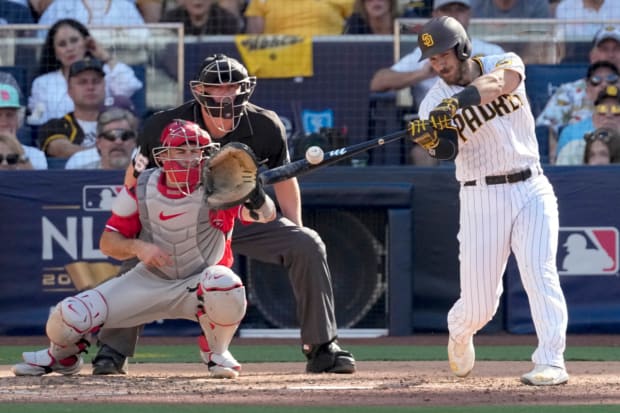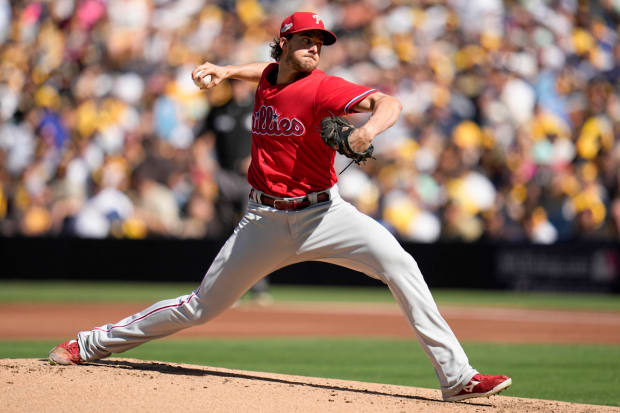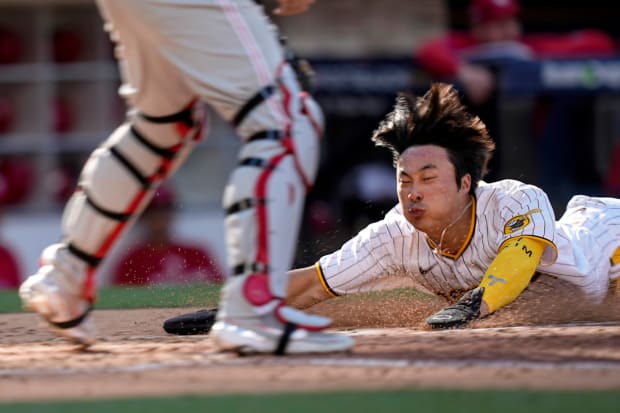SAN DIEGO — The hitter strode up to the plate. He had been waiting for a moment like this for a long time: A close playoff game, his team losing, a runner on. He looked to the mound, and he saw the face most familiar to him in the world, the pitcher he knew most intimately.
He stepped into the box against his younger brother.
There were brothers who had played each other in the postseason before. But there had never been brothers who faced each other: There had never been a pitcher on one team, a position player on the other, to come up against one another in October.
There had never been anyone tasked with doing what Padres catcher Austin Nola and Phillies starting pitcher Aaron Nola did on Wednesday.
The pair had faced each other either six times or several thousand times before they met today in Game 2 of the NLCS. There were three plate appearances in a game last August (strikeout, pop fly, walk) and three more in a game this June (groundout, strikeout, single) and before that, countless unofficial ones in their backyard, just kids playing wiffle ball. They know how this feels. It’s one of the best things they can experience on a diamond—the ultimate form of competition, permanent bragging rights on the line, only streaked with empathy and love. The first time they faced each other in the big leagues, Austin found himself wishing he could freeze the moment. “I wished I could just press pause on the time button,” he said, “Just live it for that much longer.” And this was how he felt after—after his brother had struck him out on three pitches.
But this one was different. The playoffs, of course, are different.
“He’s so locked in,” Austin said of how it feels to face Aaron. “He does not stop staring at me. So I said this time—I said, I’m not stepping out of the box. Every pitch, I’m going to stay in the box and stare at him the whole time, and see what happens.”
Which brought him to the plate in the fifth inning. The Padres were down 4–2, trying to mount a comeback after originally falling behind 4–0. There was a runner on first with one out; the speedy San Diego shortstop Ha-Seong Kim had started the inning by singling off Aaron. That meant Austin could represent the tying run for the Padres.
He stepped into the box against his younger brother, and he stared.

Ashley Landis/AP
1. Throw to first
Aaron begins by trying to pick off Kim. Fine, Austin figures. He could wait.
The catcher is older than the pitcher by three and a half years. Their relationship as kids was as typical as could be: Austin never let Aaron win at anything, “no matter what we did or what we played, what sport it was,” Aaron said. That helped make him more competitive. It also made him idolize his brother.
“Growing up, I always wanted to be as good as him,” Aaron said. “I went to almost every one of his baseball games, basketball games, football games.”
But the dynamic shifted eventually. When Austin was a senior in high school, Aaron a freshman, the varsity coach had the frosh pitch to three of their best hitters one day, Austin first.
Aaron blew a fastball by Austin. Then he broke his bat. The older had watched enough of the younger dominating in Little League, “but that’s Little League, right?” He didn’t realize his kid brother could pitch like this. After getting him out on that broken-bat grounder, Aaron struck out the next two hitters, and Austin thought for the very first time: Man. He’s good.
He’d keep thinking it for a long, long time.
2. Throw to first
Another pickoff attempt. That’s fine. Austin could wait some more.
After overlapping that one year in high school, they overlapped for one year in college, too, when both chose to play at LSU. (The pair helped lead the Tigers to the SEC championship in 2012.) Next, however, their paths diverged. Austin was drafted in the fifth round by the Marlins. Aaron, meanwhile, became one of the best pitchers in college baseball. While Austin began a long, grinding path through the minors, Aaron began the rise that would make him a top-10 draft pick for the Phillies in ‘14.
“He probably could have made it to the big leagues right out of college,” Austin said of Aaron. “He didn’t even need to go to the minor leagues.”
Aaron did spend a few months in the minors. But Austin was right: He didn’t really need them. Aaron made his big-league debut the next year, finishing his rookie year with a 3.59 ERA (107 ERA+), and he never looked back.
The younger brother had made it. The older brother still had years to go.
3. Throw to first
One more attempted pickoff. O.K. Sure, Austin would wait a bit longer.
While Aaron was securing his footing in MLB, Austin was still in Triple A. He would stay there for all of 2015, and ‘16, and ‘17, and ‘18. In the middle of that stretch, frustrated and beginning to feel lost, he converted from his original position of shortstop to catcher—anything to make him feel like he still had a chance. (He’d grown up catching Aaron in the backyard, after all.) It was a difficult transition, but he did it, and maybe, he thought, maybe this would be it.
It wasn’t. Austin played 718 career minor-league games across six years in the Marlins’ system, but after that, his time with the organization was up. He’d never been to the majors—never really been close. He was getting close to turning 30.
“I was like, my younger brother has been in the big leagues for (almost) five years, and I haven't tasted it yet,” Austin said.
Aaron made his first All-Star team that year. He was a finalist for the Cy Young and received a few votes for MVP. That winter, he signed a four-year, $45-million contract extension with the Phillies.
Austin signed a minor-league deal with the Mariners. Maybe this was it, he figured. He didn’t know what would come next if it wasn’t.

Gregory Bull/AP
4. Count 0–0: 89 mph cutter
Finally. Austin has not stopped staring at his brother. But he gets only a piece of this first pitch: Foul.
He’d been right: That minor-league deal with the Mariners was it. Things clicked for him over a few months at Triple-A Tacoma, and in June 2019, he finally got the call he had been waiting on for years.
When he did, Aaron was playing with the Phillies in Atlanta. His mother sent him a text to share that his older brother had been called up, and when he checked his phone in the clubhouse afterward, “it brought tears to my eyes.” Austin made his debut the next day against the A’s; Aaron, back on the East Coast, felt lucky he could watch it after his own game because of the time difference.
“Just knowing how hard he worked to get to that position,” Aaron said, “It was really special.”
All the wiffle ball in the backyard; the years of playing with each other, against each other, for each other; the growing and teasing and scrapping—this was where it led. The Nola boys were finally big-leaguers both.
Austin singled in his first major-league at bat. Some 2,500 miles away, his younger brother was watching, and he could not have been more proud.
5. Count 0–1: 94 mph fastball
This is a high fastball, the kind he should know to lay off, yet Austin can’t help it: He swings and misses. But there can’t be too much shame in that. There’s a reason, after all, that Aaron had yet to allow an earned run this postseason before today. This has been one of the stronger years of his career—the lowest walk rate in the National League and the highest strikeout-to-walk rate in baseball—and he’s been at his best in the playoffs.
But it’s still hard for their parents to watch. The two of them, A.J. and Stacie, are in the crowd, and they feel like they live and die with every pitch. A.J. has on a Padres hat with a layered combo of Aaron’s Phillies jersey over Austin’s Padres jersey. Stacie went the opposite direction: She couldn’t wear any team gear at all.
“I know where their heads are at when Aaron pitches,” Austin said. “That’s the baby of the family. He pitches once every five days. They’re really rooting for him hard.”
Of course. But they’re rooting for Austin, too.
“It’s tough,” A.J. said later, in the bowels of the stadium, between his sons’ two clubhouses. “Bittersweet.”
Yet their father smiled as he said it.
6. Count 0–2: 93 mph sinker
Austin has to foul this one off just to stay alive.
“Typical at bat against my brother,” he grinned later. “0–2.”
After he was traded from Seattle to San Diego just before the 2020 trade deadline, he figured he’d end up here, getting at bats against his brother, because both would be playing in the National League. Austin was ready for this part.

Brynn Anderson/AP
7. Throw to first
Austin stays fixated on Aaron. This was the game plan: Don’t step out of the box, don’t lose your stare, don’t let him break your concentration.
Isn’t it strange that no one has done this? They both like baseball history. They know about the other brothers who have played each other in the postseason, the Alomars, the Boyers. But they also know that no one has done this, stepping into the box against his brother, getting on the mound against him.
“You can’t really lean on anybody in this, right?” Austin said. “There’s no—you can’t lean on, hey, how do you handle this situation?”
Of course, there’s one person he could talk to. There’s one person who understands. He looks at him, 60 feet, six inches away, and figures he’ll ask him about it soon enough.
8. Count 0–2: 95 mph sinker
The pitch is another sinker—this one thrown harder than the last, but with far less sink, left up in the zone. (“Mislocation,” Phillies manager Rob Thomson would call it later.) The younger brother is frustrated. The older brother is ready.
He’s been waiting for a moment like this for a long time. Maybe his whole life. It is a single, and it is everything he could have wanted.
Kim goes on contact, and he tears around the bases, second, third, into home. It’s the first run of the inning—cutting the Phillies’ lead to just 4–3—but it would not be the last.
Soon, Austin Nola would score the tying run, and Aaron Nola would be knocked out of the game, and the Padres would eventually win, 8–5.
They’ll probably have dinner together after the travel day on Thursday, A.J. said. He’s sure the family will have a lot to talk about.







